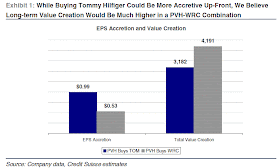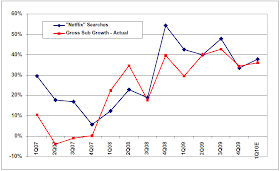Credit Suisse is making a major call on Louisiana-Pacific (NYSE:LPX) upping their target to $14 (prev. $11), reiterating Outperform rating and most importantly raising their EPS estimates way above consensus.
Firm notes the price of benchmark (North Central 7/16") oriented strand board (OSB) has jumped 25% since December, rising almost twice its normal seasonal rate through the first quarter. OSB stood at $248 per thousand square feet (msf) at the end of last week, up 70% from $146/msf exactly one year ago. This $248 level is the highest OSB price seen since the second quarter of 2006 – when LPX earned $0.52 per share.
- CSFB estimates that the OSB industry lost EBITDA virtually continuously from the fourth quarter of 2006 until this quarter – or for more than three years! Over 30% of North American structural panels (plywood and OSB) capacity has been closed since -- but this misses the point. Much of the remaining capacity cannot "run full" as major elements of the supply chain – from "lumberjacks" cutting trees to trucks hauling finished products to wholesalers/distributors -- have been destroyed across North America. As seen in the 2003-05 OSB price recovery, it takes years for industry players to “believe” the upturn, as seasonal crosscurrents can prove confusing.
They believe the current rally, despite the still-weak housing start environment, is a result of the collateral damage to the supply chain during this "Great Recession." No doubt also that inventories across the remaining supply chain have been cut to the bone. In addition, the firm believes that repair and renovation activity has bounced back enough to create a bit better demand than last year at this time.
They highlight the weekly average OSB price going back 10 years, and compare these prices to annual housing starts. Firm notes that OSB prices have jumped more than average in the first quarter of 2010 despite the continued-weak housing starts.

Specific Product Price/EPS Estimate Changes
As a result of the surprising strength of the first quarter wood products rally, and CSFB's assumption that demand will gradually (and not just suddenly) improve over the next several years (as demographic realities kick in), they are increasing their wood products pricing forecast. In addition, the firm is increasing their EPS forecast for LPX at this time -- though they note that higher pricing forecasts for wood products will benefit a number of other companies.

The Street Sleeps: 2003 All Over Again?
CSFB notes that even before they raised their estimates on Louisiana-Pacific, they had by far the highest 2011 EPS estimates on the Street – so high that they are not included in the consensus calculations! Well, if they had a problem before, they’ll have an even bigger one now. However, for those of you who watched CSFB's coverage of the wood products industry from TriBeCa during the early days of the 2003-05 wood products pricing upcycle, you will know that they will not wait for the pack! Simply, all they are doing is assuming that current prices are sustainable, not just a one-shot rally in a never-ending depression. We will enter 2011 after the three lowest housing starts years in half a century and with net household formations at or near a record level. Please note that CSFB's new 2013 peak projection for LPX is “just” $2.25/share – about half the EPS produced at the last peak (which is consistent with LPX having a better balance sheet in 2013, offset by 30% more diluted shares and 40% lower peak operating margins in OSB). In other words, they are not looking at a “pie in the sky” scenario by any stretch!
Louisiana-Pacific has huge leverage to OSB pricing, with a $25/msf change having a $0.35/share EPS impact with "depressed" production levels (as seen since 2008) and a $0.45-$0.55/share impact under more "normal" production levels
Notablecalls: Actionable Call alert! Actionable Call alert! Actionable Call alert!
Just take a look at Credit Suisse's EPS estimates for 2010 & especially the outer years. And these guys have seen it all before.
If CSFB is right with their "just" 2.25/share EPS estimate for 2013, you're looking at a double-to-triple ($18 to $24 per share) share price by mid-2011. I suspect every U.S. based fund manager will be telling their analysts to start looking at the space after today.
I'm guessing LPX will trade up today to the tune of 6-9%+, putting $9.50+ level possibly in play. Note that there is a 12% short interest in the name.
I'm really-really hoping for a decent entry right after open so everyone can get size before price escapes to the upside.
Note that Barclays is also out positive on the space this morning boosting EPS for timber and wood product rich companies such as WY, LPX, RYN, and PCL. They believe the risk to their above consensus estimates remains to the upside.
Firm notes the price of benchmark (North Central 7/16") oriented strand board (OSB) has jumped 25% since December, rising almost twice its normal seasonal rate through the first quarter. OSB stood at $248 per thousand square feet (msf) at the end of last week, up 70% from $146/msf exactly one year ago. This $248 level is the highest OSB price seen since the second quarter of 2006 – when LPX earned $0.52 per share.
- CSFB estimates that the OSB industry lost EBITDA virtually continuously from the fourth quarter of 2006 until this quarter – or for more than three years! Over 30% of North American structural panels (plywood and OSB) capacity has been closed since -- but this misses the point. Much of the remaining capacity cannot "run full" as major elements of the supply chain – from "lumberjacks" cutting trees to trucks hauling finished products to wholesalers/distributors -- have been destroyed across North America. As seen in the 2003-05 OSB price recovery, it takes years for industry players to “believe” the upturn, as seasonal crosscurrents can prove confusing.
They believe the current rally, despite the still-weak housing start environment, is a result of the collateral damage to the supply chain during this "Great Recession." No doubt also that inventories across the remaining supply chain have been cut to the bone. In addition, the firm believes that repair and renovation activity has bounced back enough to create a bit better demand than last year at this time.
They highlight the weekly average OSB price going back 10 years, and compare these prices to annual housing starts. Firm notes that OSB prices have jumped more than average in the first quarter of 2010 despite the continued-weak housing starts.

Specific Product Price/EPS Estimate Changes
As a result of the surprising strength of the first quarter wood products rally, and CSFB's assumption that demand will gradually (and not just suddenly) improve over the next several years (as demographic realities kick in), they are increasing their wood products pricing forecast. In addition, the firm is increasing their EPS forecast for LPX at this time -- though they note that higher pricing forecasts for wood products will benefit a number of other companies.

The Street Sleeps: 2003 All Over Again?
CSFB notes that even before they raised their estimates on Louisiana-Pacific, they had by far the highest 2011 EPS estimates on the Street – so high that they are not included in the consensus calculations! Well, if they had a problem before, they’ll have an even bigger one now. However, for those of you who watched CSFB's coverage of the wood products industry from TriBeCa during the early days of the 2003-05 wood products pricing upcycle, you will know that they will not wait for the pack! Simply, all they are doing is assuming that current prices are sustainable, not just a one-shot rally in a never-ending depression. We will enter 2011 after the three lowest housing starts years in half a century and with net household formations at or near a record level. Please note that CSFB's new 2013 peak projection for LPX is “just” $2.25/share – about half the EPS produced at the last peak (which is consistent with LPX having a better balance sheet in 2013, offset by 30% more diluted shares and 40% lower peak operating margins in OSB). In other words, they are not looking at a “pie in the sky” scenario by any stretch!
Louisiana-Pacific has huge leverage to OSB pricing, with a $25/msf change having a $0.35/share EPS impact with "depressed" production levels (as seen since 2008) and a $0.45-$0.55/share impact under more "normal" production levels
Notablecalls: Actionable Call alert! Actionable Call alert! Actionable Call alert!
Just take a look at Credit Suisse's EPS estimates for 2010 & especially the outer years. And these guys have seen it all before.
If CSFB is right with their "just" 2.25/share EPS estimate for 2013, you're looking at a double-to-triple ($18 to $24 per share) share price by mid-2011. I suspect every U.S. based fund manager will be telling their analysts to start looking at the space after today.
I'm guessing LPX will trade up today to the tune of 6-9%+, putting $9.50+ level possibly in play. Note that there is a 12% short interest in the name.
I'm really-really hoping for a decent entry right after open so everyone can get size before price escapes to the upside.
Note that Barclays is also out positive on the space this morning boosting EPS for timber and wood product rich companies such as WY, LPX, RYN, and PCL. They believe the risk to their above consensus estimates remains to the upside.


















